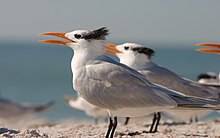Royal tern
| Royal tern | |
|---|---|
 |
|
| Winter plumage | |
| Scientific classification | |
| Kingdom: | Animalia |
| Phylum: | Chordata |
| Class: | Aves |
| Order: | Charadriiformes |
| Family: | Sternidae |
| Genus: | Thalasseus |
| Species: | T. maximus |
| Binomial name | |
|
Thalasseus maximus (Boddaert, 1783) |
|
 |
|
| Range of T. maximus | |
| Synonyms | |
|
Sterna maxima |
|
Sterna maxima
The royal tern (Thalasseus maximus) is a seabird in the tern family Sternidae. The genus name is from Ancient Greek Thalasseus, "fisherman", from thalassa, "sea". The specific maximus is Latin for '"greatest".
This bird has two distinctive subspecies: T. m. maximus which lives on the Atlantic and Pacific coasts of the North and South America, and the slightly smaller T. m. albididorsalis lives on the coast of West Africa. The royal tern has a red-orange bill and a black cap during the breeding season, but in the winter the cap becomes patchy. The royal tern is found in Europe, Africa, the Americas, and the Caribbean islands. The royal tern lives on the coast and is only found near salt water. They tend to feed near the shore, close to the beach or in backwater bays. The royal tern's conservation status is listed as least concern.
The royal tern belongs to the class Aves and the order Charadriiformes. Charadriiformes are mainly seabirds of small to medium-large size. The royal tern is also in the family Sternidae because of its white plumage, black cap on its head, long bill, webbed feet, and bodies that are more streamlined than those of gulls.
The taxonomy of the royal tern has been debated, whether the correct scientific name was Thalasseus maximus or Sterna maxima. It is presently classified as Thalasseus maximus, which places it with five other seabirds from the tern family. The royal tern was originally placed in the genus Sterna; however, a 2005 study suggest that it is actually part of the genus Thalasseus. The royal tern is currently divided into two subspecies: Thalasseus maximus maximus and Thalasseus maximus albididorsalis. T. m. maximus is found on the East Coast of North America and is referred to as the "New World" species. T. m. albidorsalis, referred to as the "Old World" species, is found on the Atlantic coast of North America, the Caribbean Islands, the East Coast of South America, and in the West coast of Africa.
This is a large tern, second only to Caspian tern but is unlikely to be confused with the carrot-billed giant, which has extensive dark under wing patches. The royal tern has an orange-red bill, pale grey upper parts and white under parts. Its legs are black. In winter, the black cap becomes patchy. Juvenile royal terns are similar to non-breeding adults. Differences include juveniles having black splotched wings and a yellower bill. An adult royal tern has an average wingspan of 130 cm (51 in), for both sexes, but their wingspan can range from 125–135 cm (49–53 in). The royal tern's length ranges from 45–50 cm (18–20 in) and their average weight is anywhere from 350–450 g (12–16 oz).
...
Wikipedia

